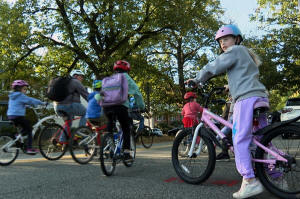From a few to more than 350, children and parents ride together to
school as a 'bike bus'
[November 06, 2025]
By TASSANEE VEJPONGSA
MONTCLAIR, New Jersey (AP) — On a sunny fall morning, children wearing
helmets and backpacks gathered with their parents in Montclair, New
Jersey, for a group bicycle ride to two local elementary schools.
Volunteers in orange safety vests made sure everyone assembled in a
neighborhood shopping area was ready before the riders set off on their
5-mile “bike bus” route.
Every few blocks, more adults and kids on bikes joined in. Eventually,
the group grew to over 350 people. Older students chatted with friends,
while younger ones focused on pedaling. Cars along the way stopped to
let the long line of cyclists pass. Pupils and parents peeled off toward
the first school before the remainder reached the group's final stop.
It’s a familiar Friday scene in Montclair. For the past three years,
what began as a handful of parents hoping to encourage their kids to
bike to school has grown into a weekly ritual for both the township of
about 40,000 residents and many of its families.
“It was so fun,” second grader Gigi Drucker, 7, said upon arriving at
Nishuane Elementary School. “The best way to get to school is by bike
because it gives you more exercise. It’s healthier for the Earth,” she
added.
But traveling to school on two wheels isn’t just for fun, according to
organizer Jessica Tillyer, whose are 6 and 8 years old. She believes
that biking together each week helps promote healthy habits for the
children and strengthens the sense of community among parents.
“And it really started because a small group of us, about five parents,
all wanted to ride to school with our kids and just felt like it wasn’t
safe. And for me, I felt kind of lonely riding by myself to school. So,
bike bus just took off as a small effort. And now we can have up to 400
people riding together to school,” Tillyer said.

The bike bus movement isn’t new. Hundreds of them exist throughout the
U.S. and Europe, as well as in Australia, Brazil, India, Indonesia and
Israel, according to Bike Bus World, a nonprofit organization that
promotes and provides information about bike buses.
Co-founder Sam Balto, who established a bike bus in Portland, Oregon,
more than three years ago, said interest has grown so much that he
offers free coaching calls to help others launch their own. He estimates
there are more than 400 routes worldwide, and the number continues to
grow.
“Children and families are craving community and physical activity and
being outdoors. And when you present that versus a school car line,
people naturally gravitate to something that’s super joyful and
community-driven,” Balto said.
Organizers hope the bike bus movement will not only get more children on
their bikes but also push elected officials in the United States and
abroad to invest in safer biking infrastructure.
While starting a bike bus may not be difficult, keeping it running
year-round through different seasons takes more effort. Organizers of
successful rides shared advice for parents hoping to create their own.
Plan and communicate
Andrew Hawkins, one of the leaders of Montclair Bike Bus, said that once
enough families express interest, the first step is to plan a route
carefully. That means identifying streets with low traffic while
considering how many students can join at the starting point and along
the way.
“It took us a while to come up with a route we were happy with, but
we’re still ready to adjust if necessary,” Hawkins said. “Things can
change. It could be that new groups of students move into a certain
block, or traffic patterns shift, and you have to adapt.”
The Montclair group started via word of mouth and social media posts. As
the number of participants grew, the organizers created a chat group to
coordinate and share weekly updates. They also reached out to other
families through PTAs, school forums and other parent communication
channels.

[to top of second column]
|

In an image taken from video, children ride their bicycles to school
during a parent-led bike ride titled "Bike Bus" Oct. 3, 2025, in
Montclair, N.J. (AP Photo/Tassanee Vejpongsa)
 One unexpected benefit, several
parents said, is the bike bus motivates children to get up and out
the door more quickly on Friday mornings.
“He’s more excited to get out of bed for the bike bus than for the
regular bus. So actually, I have an easier time getting him ready
for school,” said Gene Gykoff, who rides with his son to the boy's
elementary school.
To keep momentum going all year, the Montclair Bike Bus team
organizes themed rides on weekends and holidays. These events also
allow families who can’t join on weekday mornings to experience what
the bike bus is all about before committing to a regular schedule.
Start young and go slow
Montclair Bike Bus consists of multiple adult-led groups and routes
that encompass all of the township's elementary schools and middle
schools. Organizers think the primary grades are when children
benefit most from cycling with a group. Students in the first few
years of school can learn about riding safely and apply those skills
when they bike on their own or in small groups as they get older.
The Montclair parents found that most elementary school students can
handle a distance of 3-5 miles, and the group travels at a speed of
around 6 miles per hour so the younger kids can keep up.
“The slow speed can be tough for some of our older kids who want to
go a little bit faster. We tell them there’s no racing on the bike
bus — everyone gets to school at the same time. But there have been
occasions where we’ve had to split the ride into two groups so that
some of the older kids can go a little bit faster than the younger
kids,” Hawkins said.
Be consistent no matter the weather
Keeping a bike bus going year-round requires consistency, which
means preparing to pedal when it's raining or cold outside, Balto
and Hawkins said. Leaders monitor weather forecasts and decide
whether to cancel a Friday ride due to unsafe conditions or to
proceed as planned while reminding families to dress appropriately.
“As it gets colder, we tell everyone to make sure they have the
right gear — gloves, neck warmers, warm jackets,” Hawkins said. “The
idea is that kids should feel comfortable riding all year.”
The Montclair bike bus secured reflective vests and bike lights from
sponsors to increase visibility on dark winter mornings. Leaders
also carry basic maintenance tools, such as tire pumps.

Weather is often more of a concern for adults than it is for
children, Balto observed. “Kids want to be outside with their
friends,” he said. “If you’re going to do this in all weather, just
do it consistently. People will get used to it, and they’ll start
joining you.”
Just do it
Despite all the planning and coordination involved in running a
regular bike bus, experienced organizers say the key is simply to
start. It can be as informal as two families riding to school
together and sharing a flyer to spread the word, Balto said.
“If you’re consistent — once a week, once a month, once a season —
it will grow,” he said.
Tillyer said she gives the same advice to anyone who asks how to
begin: just go for it.
“Don’t ask for permission. Don’t worry about what it’s going to
take,” she said. “Find a small group of people, get on your bikes
and ride to school. Once people experience it and enjoy it, more
will want to join.”
All contents © copyright 2025 Associated Press. All rights reserved |